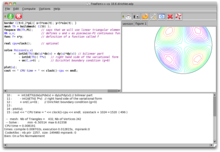 FreeFem++-cs | |
| Developer(s) | Université Pierre et Marie Curie and Laboratoire Jacques-Louis Lions |
|---|---|
| Initial release | 1987 |
| Stable release | 4.9
/ April 19, 2021 |
| Repository | github |
| Written in | C++ |
| Operating system | Linux, macOS, Microsoft Windows, Solaris |
| License | LGPL version 2.1 or later |
| Website | freefem |
FreeFem++ is a programming language and a software focused on solving partial differential equations using the finite element method. FreeFem++ is written in C++ and developed and maintained by Université Pierre et Marie Curie and Laboratoire Jacques-Louis Lions. It runs on Linux, Solaris, macOS and Microsoft Windows systems. FreeFem++ is free software (LGPL).[1][2]
FreeFem++ language is inspired by C++. There is an IDE called FreeFem++-cs.
YouTube Encyclopedic
-
1/3Views:1 1618 49614 946
-
L15 Solution to 2D elasticity with FreeFEM++ and visualization with Paraview
-
Frédéric Hecht: Tutorial with Freefem++
-
Open-source FEA: A short Introduction (Part 1)
Transcription
History
The first version was created in 1987 by Olivier Pironneau and was named MacFem (it only worked on Macintosh); PCFem appeared some time later. Both were written in Pascal.
In 1992 it was re-written in C++ and named FreeFem. Later versions, FreeFem+ (1996) and FreeFem++ (1998), used that programming language too.
Other versions
- FreeFem++ includes versions for console mode and MPI
- FreeFem3D
Deprecated versions:
- FreeFem+
- FreeFem
See also
References
- ^ Hecht, Frédéric (2012). "New development in FreeFem++" (PDF). Journal of Numerical Mathematics. 20 (3–4): 251–266. doi:10.1515/jnum-2012-0013. S2CID 12770876.
- ^ "FreeFem++ website". Retrieved November 27, 2018.
External links
